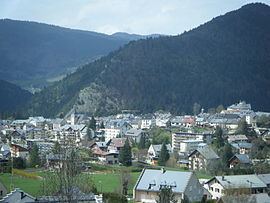Local time Monday 4:38 PM | Intercommunality Massif du Vercors | |
 | ||
Elevation 720–2,286 m (2,362–7,500 ft) Weather 13°C, Wind N at 11 km/h, 54% Humidity Points of interest Espace Villard de Lans Corr, Villard de Lans, Casino de Villard de lans, La Grande Moucherolle, Valchevrière | ||
Villard de lans le village qui ne manque pas d air
Villard-de-Lans is a commune in the Isère department of the Auvergne-Rhones-Alpes region in southeastern France. The town is also situated in the Vercors Massif. It was the administrative centre of the eponymous canton until the departmental elections of 2015. After the elections, Villard-de-Lans and the communes of its former canton were all incorporated into the new Fontaine-Vercors canton. The town remains the seat of the Community of Communes in the Vercors Massif (CCMV).
Contents
- Villard de lans le village qui ne manque pas d air
- Map of 38250 Villard de Lans France
- History
- World War II
- 1968 Winter Olympics
- Winter Sports
- Twin towns Sister cities
- References
Map of 38250 Villard-de-Lans, France
The town is a centre for skiing in winter, as well as hiking and hot air ballooning during the other seasons. It is also the town with the largest amount of available lodging in the entire Vercors Regional Natural Park.
History
Starting in 1906, the town of Villard-de-Lans was recognized as a ski resort. More facilities were built during the 1920s that allowed the town to host its first bobsled and luge competition in 1931.
For over a decade, the town was connected to the prefecture centre of Grenoble by a tram called the Tramway Grenoble - Villard-de-Lans. The tram, which also serviced the towns of Lans-en-Vercors and Saint-Nizier-du-Moucherotte, had completely seized operations by 1949.
World War II
During World War II, Villard-de-Lans was host to the only Polish high school in Occupied Europe. There is a plaque on the old building memorializing the names of the numerous students and teachers were deported to camps by the occupying force during the war.
The region was home to several thousand Poles, people in hiding, military defectors and evaders, as well as members of the French Resistance. Due to these circumstances, and its proximity to Grenoble, the historically rural and mountainous commune of Villar-de-Lans became a refuge for the resistance against the German occupation and led to the formation of the Maquis du Vercors, a group of fighters that were part of the French Forces of the Interior.
After the war, Charles de Gaulle paid hommage to the fighters of the Vercors by visiting Villard-de-Lans in 1948. During his visit, de Gaulle gave a speech in which he tried to discuss the controversy, which was still very strong at the time, vis-à-vis the attitude of Free France's leader and allies regarding the Maquis du Vercors.
1968 Winter Olympics
During the 1968 Winter Olympics held in neighbouring Grenoble, Villard-de-Lans played host to the luge events. Costing FRF 3,190,000 to complete, the Olympic luge track was completed using 1,400 cubic metres (49,000 cubic feet) of earthwork and 1,800 cubic metres (64,000 cubic feet) of reinforced concrete. The facility had three start houses, 132 lighting posts, telephone circuitry, 40 loudspeakers, and a signalling system for the competitors.
No turn names are given for the track. Data from the women's singles or men's doubles also not given.
Winter Sports
Villard-de-Lans has many options to participate in Winter Sports including:
Twin towns — Sister cities
Villard-de-Lans is twinned with:
